Delhi printable map of top tourist attractions & city travel guide
Delhi city centre free travel guide - Top 10 must-see sights & best destinations - Delhi top tourist attractions map
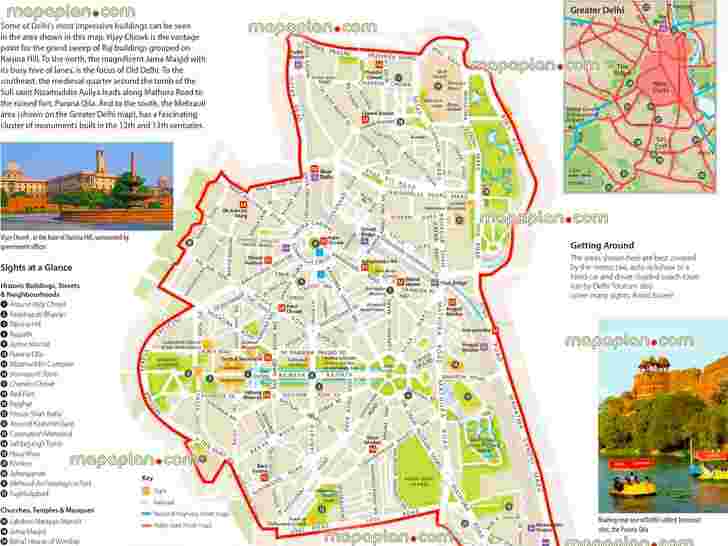

Maps of best attractions in Delhi, India
Delhi maps will guide you to the best destinations in the city. Some of Delhi’s most impressive buildings can be seen in the areas shown on our maps. Vijay Chowk is the vantage point for the grand sweep of Raj buildings grouped on Raisina Hill. To the north, the magnificent Jama Masjid mosque with its busy streets, is the focus of Old Delhi. To the southeast, the medieval quarter around the tomb of the Sufi saint Nizamuddin Auliya leads along Mathura Road to the ruined fort, Purana Qila. And to the south, the Mehrauli area (shown on the Greater Delhi map), has a fascinating cluster of monuments. Delhi top sights and key landmarks to visit are plotted on our detailed city plans. Public transportation points are also marked, and indicated by the symbols listed in the maps key. Armed with these maps, you should be able to find the accurate location of must-see places. Mapping out a trip to explore Delhi can be far from the usual. This page includes a range of maps and plans which will help you make the most of your visit to Delhi. If you are either a first-time tourist looking for the top 10 must-do sights or if you are returning to Delhi to discover something new - all you need to ensure an enjoyable trip is some advance planning. For some help in narrowing down the options, we present you with a range of high resolution maps which will help you find the detailed locations of the must-see sights - just click on a selected map to access a large version that can be downloaded and printed, or saved onto your mobile device. When in Delhi, you can also get free pocket-size maps of the city from the tourist information centre located in Connaught Place.
New Delhi, India virtual interactive 3d map - City center free printable visitor's detailed tourist guide download showing inner city old & new town buildings, must-see sights, sightseeing places of interest, Jami Masjid, Connaught Place (CP), Red Fort - Delhi top tourist attractions map
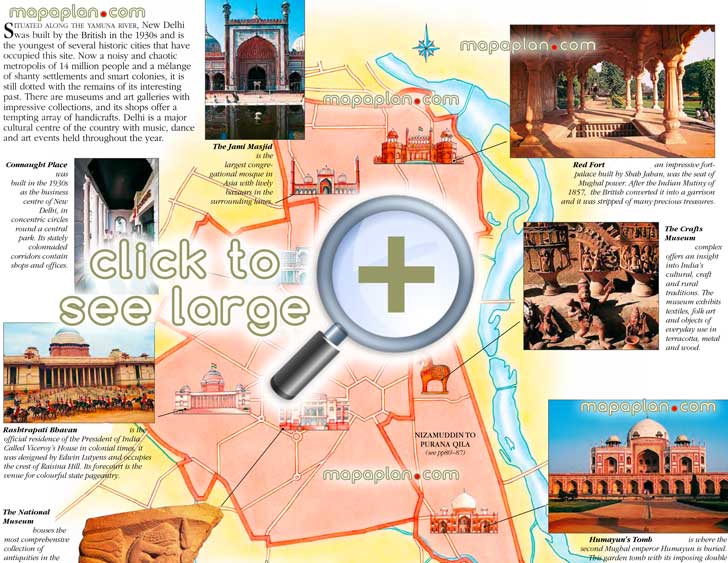
You can view, download or print a full, high resolution (detailed, large) version of this image by clicking on the plan itself
New Delhi central free to download offline city street map of top attractions - Detailed walking itinerary popout interactive guide in English showing historical streets, parks, best museums, art galleries, churches, shopping, tourist information tourism office, city centre top attractions - What to see, where to go, directions to interesting things to do - Delhi top tourist attractions map
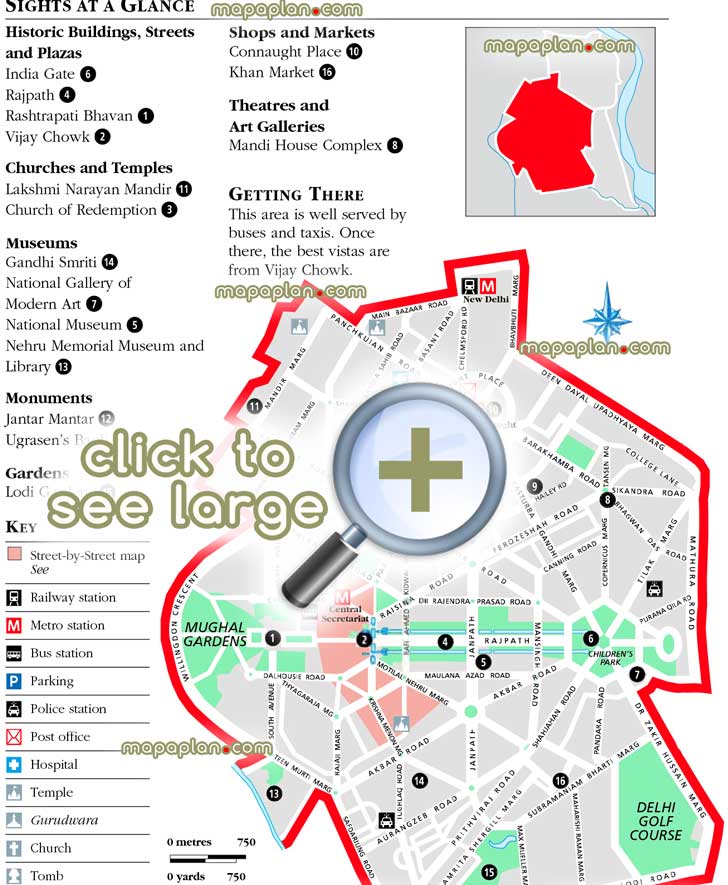
You can view, download or print a full, high resolution (detailed, large) version of this image by clicking on the plan itself
Old Delhi printable detailed interactive virtual city centre map - Downloadable tourist guide for visitors in English showing must-see places, free to download layout plan - Offline travel map showing places to visit, must-see tourist attractions, famous destinations, Jami Masjid, Rajghat - Delhi top tourist attractions map
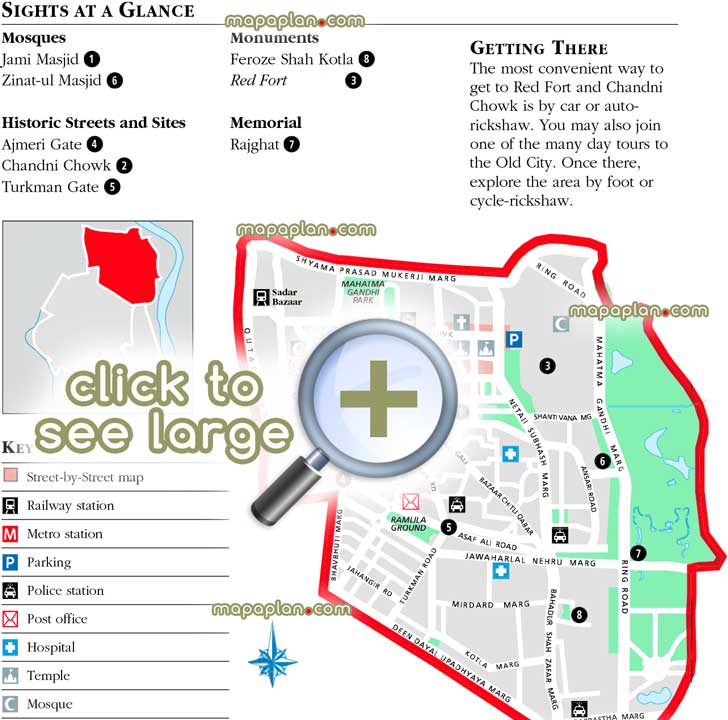
You can view, download or print a full, high resolution (detailed, large) version of this image by clicking on the plan itself
Nizamuddin district in Delhi - Free to download city centre interactive visitor's guide with directions to interesting sights around main railway station, simple & easy to navigate diagram showing holiday top points of interest - Central district neighourhood orientation - Delhi top tourist attractions map

You can view, download or print a full, high resolution (detailed, large) version of this image by clicking on the plan itself
Red Fort in Central Old Delhi city 3d monuments plan - Historic city centre printable map showing directions to sightseeing places with the list of best sights & destinations to visit - Delhi top tourist attractions map
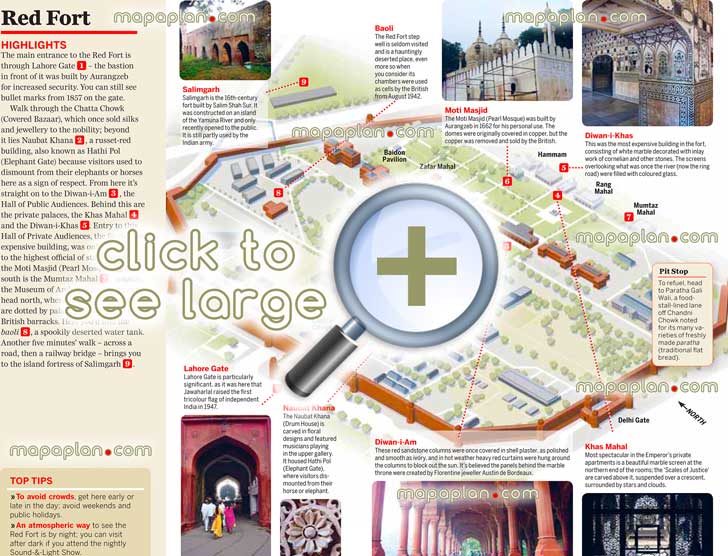
You can view, download or print a full, high resolution (detailed, large) version of this image by clicking on the plan itself
Vijay Chowk in New Delhi interactive virtual map - Central district top highlights guide map in English - Printable sightseeing plan with tourist information - Itinerary planner with navigation directions to best sights, landmark spots, travel sites, points of interest - Delhi top tourist attractions map

You can view, download or print a full, high resolution (detailed, large) version of this image by clicking on the plan itself
Chandni Chowk in Old Delhi visitor's 3d virtual interactive information plan to download - Main points of interest, monuments, museums, landmarks, destinations - Delhi top tourist attractions map

You can view, download or print a full, high resolution (detailed, large) version of this image by clicking on the plan itself
New & Old Delhi city detailed street names map around central areas - Offline download & virtual interactive hd plan with overview of the city trip highlights, metro stations, central train station, tourist information centre, roads - High quality large scale vector aerial satellite poster view - Delhi top tourist attractions map
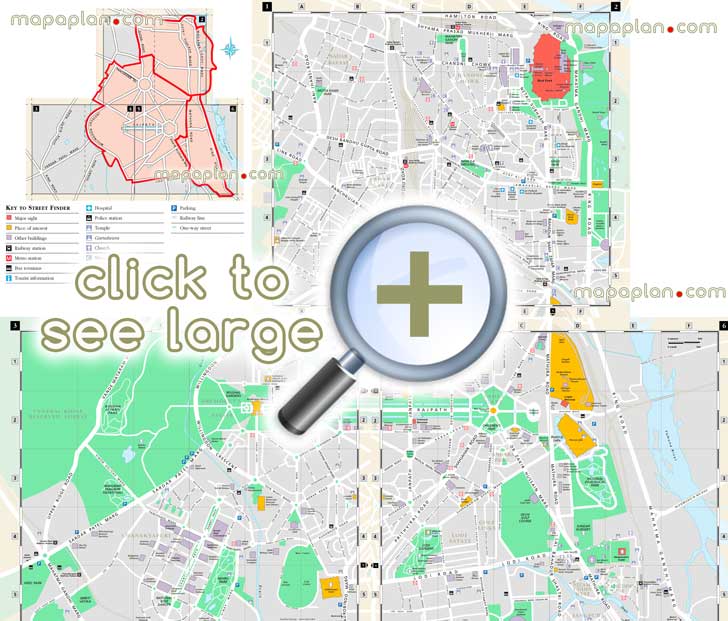
You can view, download or print a full, high resolution (detailed, large) version of this image by clicking on the plan itself
HoHo hop-on hop-off bus map of Delhi city sightseeing tour route for tourists - Visitor's 3d virtual interactive information plan with main points of interest, popular places, museums, landmarks - Bird's eye graphical overview of the city trip highlights - Delhi top tourist attractions map
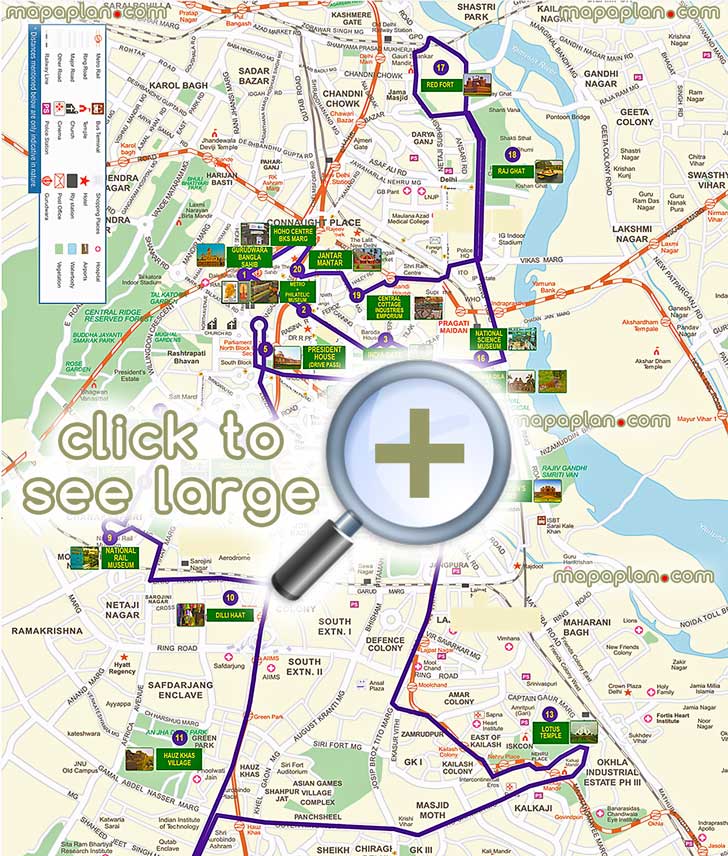
You can view, download or print a full, high resolution (detailed, large) version of this image by clicking on the plan itself
Central Delhi City center pop up map - Free to download & print 1-day trip travel guide with locations of major attractions, great historic spots, best must-see sights, detailed view map showing orientation & navigation directions - Delhi top tourist attractions map

You can view, download or print a full, high resolution (detailed, large) version of this image by clicking on the plan itself
Old Delhi detailed map - Interactive itinerary planner with the list of top things to visit & see - Delhi top tourist attractions map
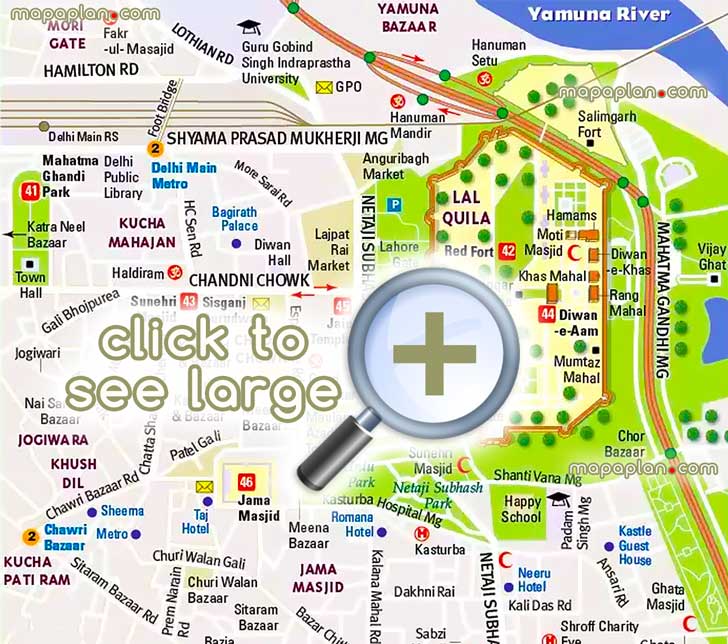
You can view, download or print a full, high resolution (detailed, large) version of this image by clicking on the plan itself
Connaught Place free printable virtual explorer plan of places to visit - Delhi top tourist attractions map
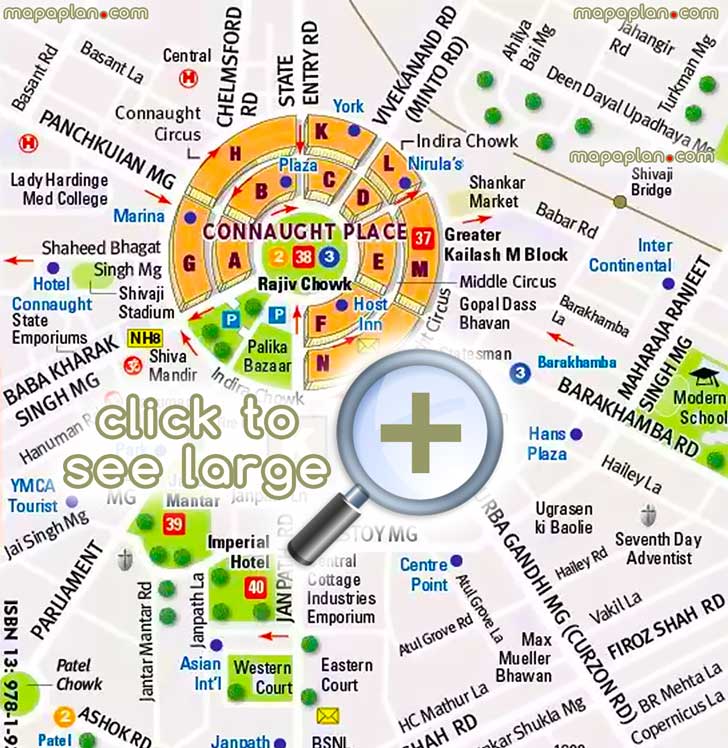
You can view, download or print a full, high resolution (detailed, large) version of this image by clicking on the plan itself
Delhi metro lines & stations - Public transport rail system transit diagram in English & Hindi - Updated network plan with city train routes, bus stops, regional & local railway interchanges - Delhi top tourist attractions map
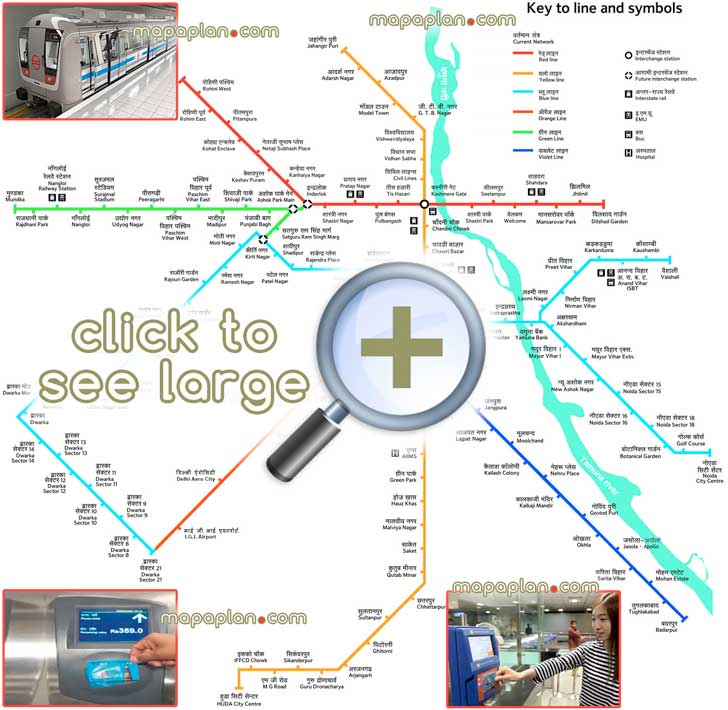
You can view, download or print a full, high resolution (detailed, large) version of this image by clicking on the plan itself
Greater Delhi metropolitan area attractions - Sightseeing tour guide itinerary planner showing layout of best things to do in Delhi state, city-break historical places to visit - Visitor's detailed virtual printable guide to download - Favourite attractions & points of interest to visit by tourists - Delhi top tourist attractions map
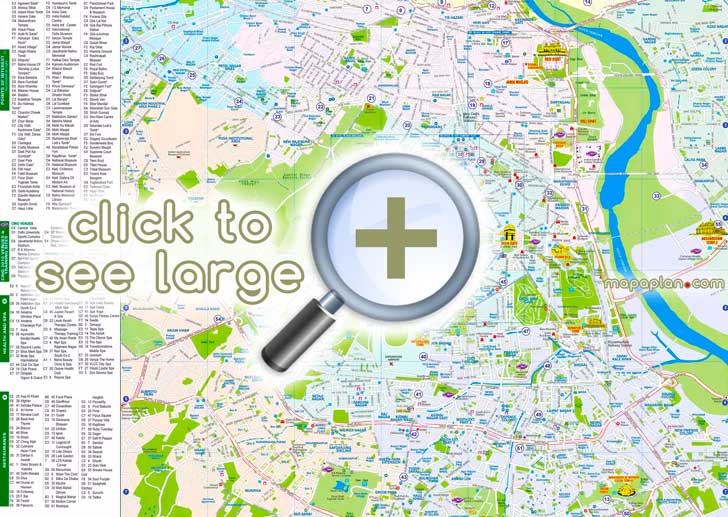
You can view, download or print a full, high resolution (detailed, large) version of this image by clicking on the plan itself
Metro interactive map with tourist places & monuments - All lines including yellow, red, blue, orange, green, violet - City centre central zone & greater Delhi metropolitan area train stations, public transport routes, airport - Delhi top tourist attractions map
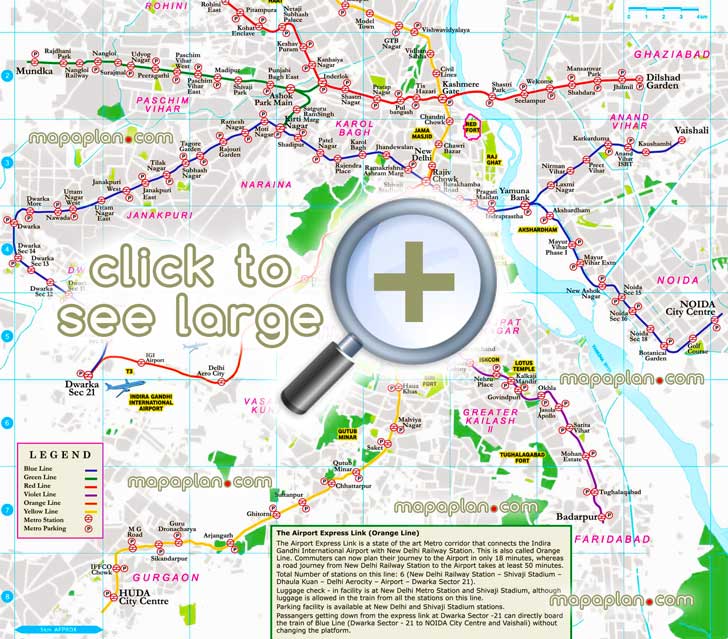
You can view, download or print a full, high resolution (detailed, large) version of this image by clicking on the plan itself
New & Old Delhi English photo image guide with neighbourhoods, major places to visit, streets, churches, temples, mosques, museums, metro public transport, Vijay, Lotus Temple, Rashtrapati Bhavan, Rajpath, Purana Qila, Humayun’s Tomb, Red Fort, Lakshmi Narayan Mandir, Delhi - Delhi top tourist attractions map

You can view, download or print a full, high resolution (detailed, large) version of this image by clicking on the plan itself
Delhi highlights map showing Red Fort, Humayun's Tomb, Qutub Minar - Delhi top tourist attractions map
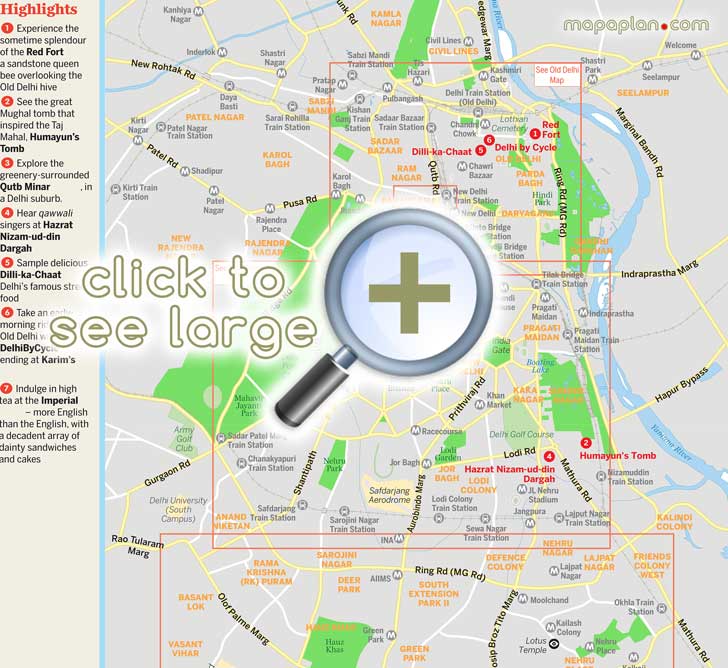
You can view, download or print a full, high resolution (detailed, large) version of this image by clicking on the plan itself
New Delhi printable map showing hotel accommodation in downtown, entertainment, best restaurants & dining - Central district area outline layout map of best locations to visit - Fun & easy to access places - Delhi top tourist attractions map
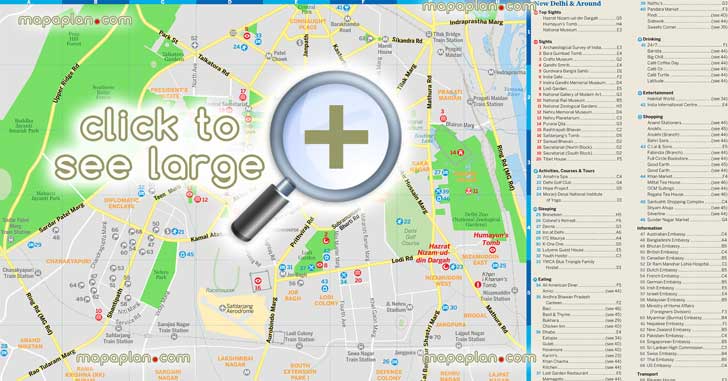
You can view, download or print a full, high resolution (detailed, large) version of this image by clicking on the plan itself
Old Delhi detailed street tourism route plan of old town square district area neighbourhood - Central district area outline layout map of best locations - Delhi top tourist attractions map
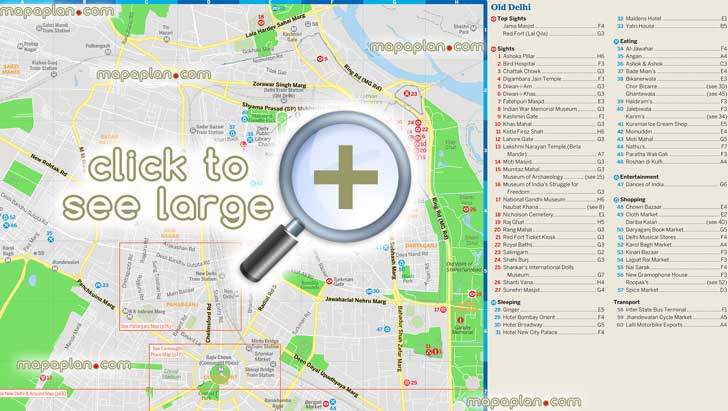
You can view, download or print a full, high resolution (detailed, large) version of this image by clicking on the plan itself
Connaught Place Delhi main district & neighbourhood - Downtown shopping destinations map showing metro station, restaurants, hotels, list of most popular shops, famous department stores within walking distance - Delhi top tourist attractions map
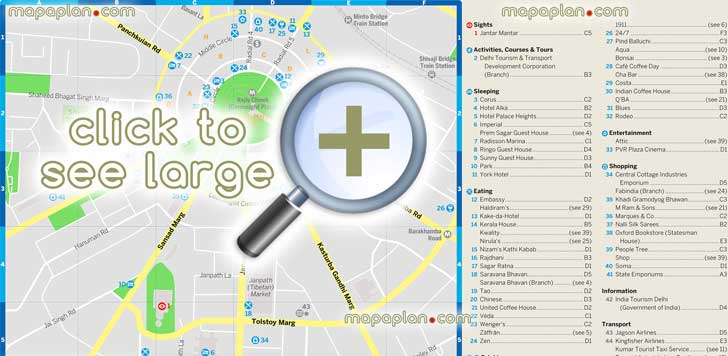
You can view, download or print a full, high resolution (detailed, large) version of this image by clicking on the plan itself
South Delhi free to download printable detailed guide map showing surrounding area attractions, roads, main districts & neighbourhoods, Lotus Temple (Bahai House of Worship) - Delhi top tourist attractions map
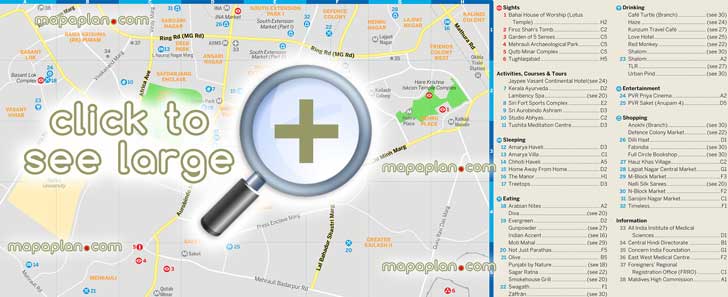
You can view, download or print a full, high resolution (detailed, large) version of this image by clicking on the plan itself
Location of Delhi on the map of India, Asia & world - Cities & places worth visiting in India including Agra, Jaipur - Delhi top tourist attractions map
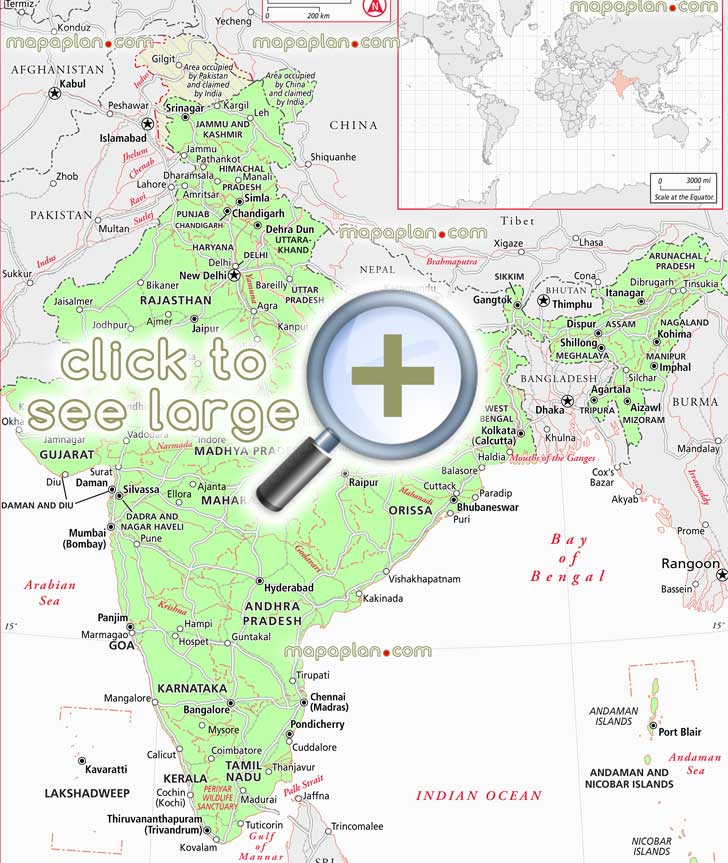
You can view, download or print a full, high resolution (detailed, large) version of this image by clicking on the plan itself
Map of New Delhi attractions, hotel accommodation, restaurants - Visitor tour & museum guide, detailed street hd map - City centre detailed pop up map of must-see attractions, interesting sites, must-do spots & landmarks - Free to download road names plan - Delhi top tourist attractions map
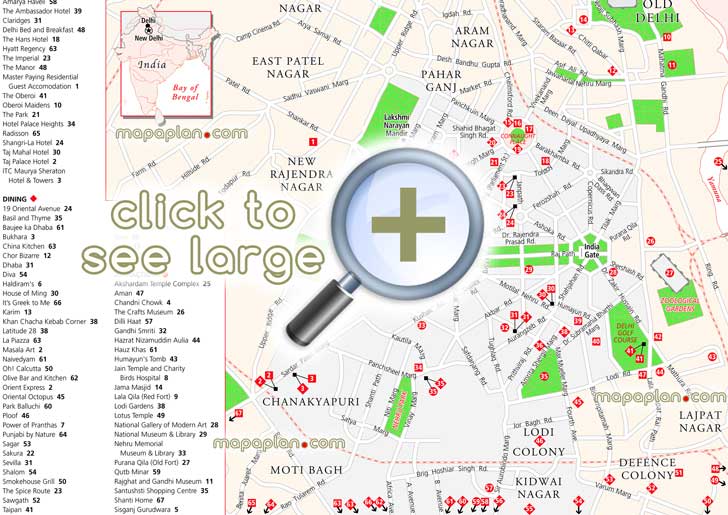
You can view, download or print a full, high resolution (detailed, large) version of this image by clicking on the plan itself
Old Delhi map showing central railway stations, Chandni Chowk, Jama Masjid, Red Fort Delhi - City center offline 3d interactive guide jpg map of main streets, sightseeing downtown attractions - Interactive walking trip downloadable itinerary planner to print & guide map showing best destinations to visit - Delhi top tourist attractions map
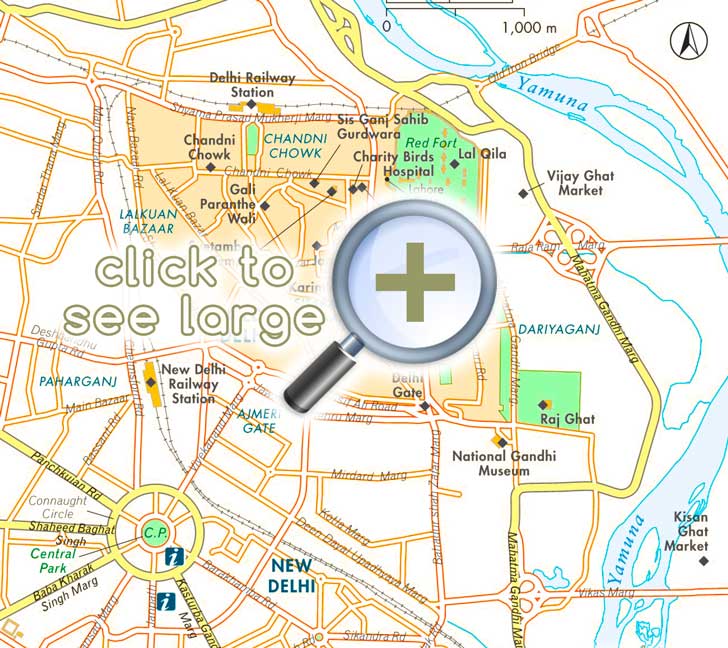
You can view, download or print a full, high resolution (detailed, large) version of this image by clicking on the plan itself
Central Delhi map of Connaught Place, India Gate, National Museum - Printable attractions map showing top spots, must-see iconic locations including India Gate, Indira Gandhi Memorial Museum, Gandhi Smriti, Jantar Mantar - Delhi top tourist attractions map
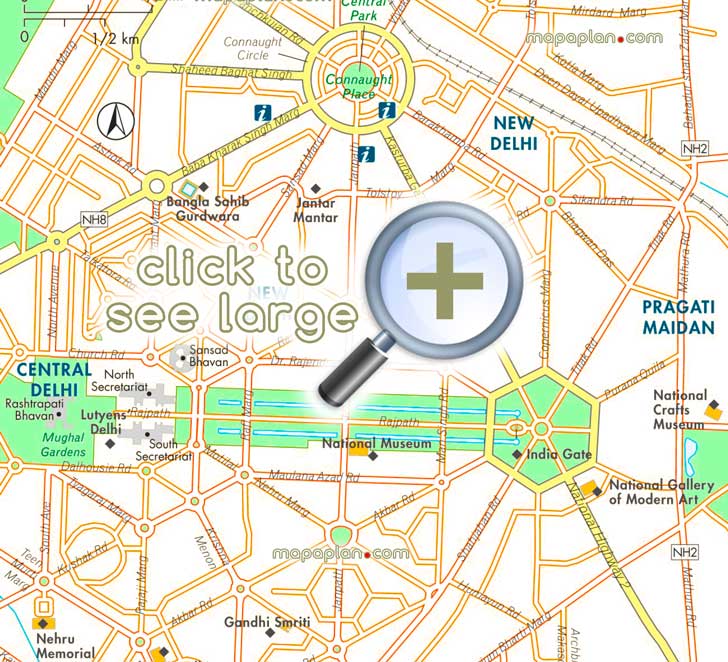
You can view, download or print a full, high resolution (detailed, large) version of this image by clicking on the plan itself
Detailed map of South Delhi showing Humayun’s Tomb, Lotus Temple, Lodi Gardens, Purana Qila - Free interactive printable detailed visitor's guide with street names, must-see destinations, hot spots worth visiting, best points of interest, old town, top sights - Delhi top tourist attractions map

You can view, download or print a full, high resolution (detailed, large) version of this image by clicking on the plan itself
Seven Cities of Delhi map with highlights including Rajpath, Paharganj, National Museum, Qutub Minar Complex - Delhi top tourist attractions map
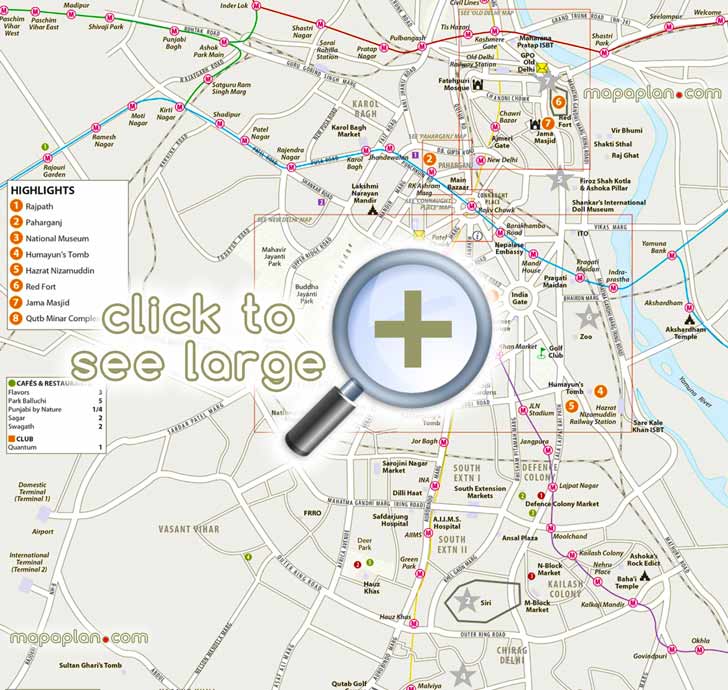
You can view, download or print a full, high resolution (detailed, large) version of this image by clicking on the plan itself
New Delhi detailed visitor's virtual map showing metro lines, hotels, shopping, restaurants - Delhi top tourist attractions map
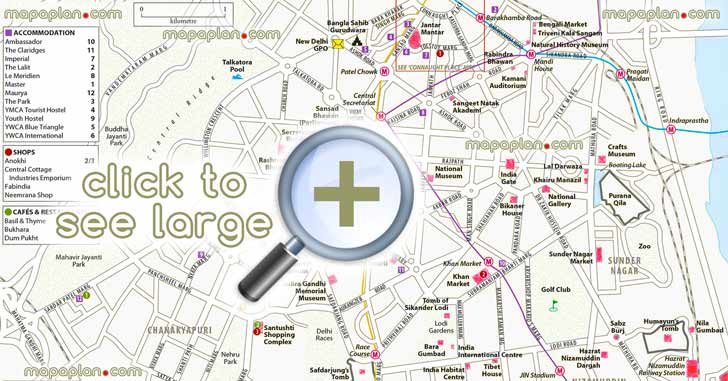
You can view, download or print a full, high resolution (detailed, large) version of this image by clicking on the plan itself
Old Delhi interactive travel map with metro lines, old junction & new rail station, Red Fort (Lal Qila), Jama Masjid - Great family things to do and explore with kids - Fun & interesting ideas where to go with children around central area - Delhi top tourist attractions map
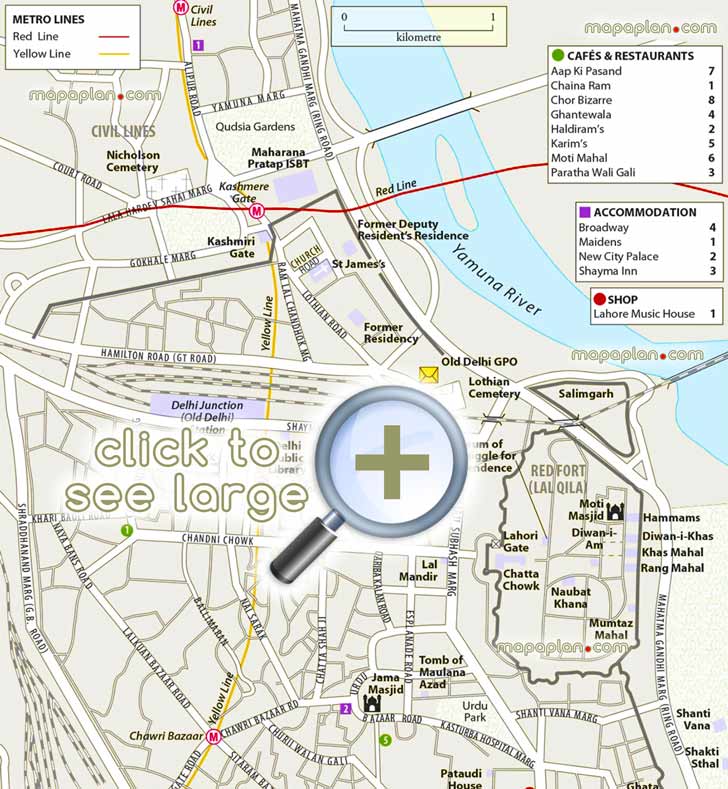
You can view, download or print a full, high resolution (detailed, large) version of this image by clicking on the plan itself
Connaught Place in Delhi top attractions & highlights - Detailed map showing famous sites to explore, Jantar Mantar, hotels, restaurants, shopping - Delhi top tourist attractions map

You can view, download or print a full, high resolution (detailed, large) version of this image by clicking on the plan itself
Paharganj visitor's map showing driving guide to New Delhi railway station & urban navigation directions - Delhi top tourist attractions map

You can view, download or print a full, high resolution (detailed, large) version of this image by clicking on the plan itself
Map of top 10 attractions in Delhi
The typical top ten attractions are listed below. You can find the detailed locations of these places on the maps above.
- Vijay Chowk - Vijay Chowk or 'Victory Square', a large piazza at the base of Raisina Hill, was planned as a commanding approach to the Viceroy's House, now the Indian President's residence. Vijay Chowk is flanked by two long, classical Secretariat buildings (the North and South Blocks), which house several ministries as well as the Prime Minister's Office.
- Lotus Temple (Bahai House of Worship) - Delhi's Baha'i Temple is an iconic piece of modern architecture that dominates the surrounding suburban sprawl. Twenty-seven spectacular giant white petals of marble in the shape of an unfolding lotus spring from nine pools and walkways, to symbolize the nine unifying spiritual paths of the Baha'i faith; each petal alcove contains an extract from the Baha'i holy scriptures. Set amid well-maintained gardens, the temple is at its most impressive at sunset. The lotus flower is a symbol of purity and spirituality throughout India, and Delhi's Baha'i Temple celebrates this in a unique architectural way. The Lotus Temple, as the Baha'i House of Worship is also known, is probably Delhi's most iconic modern holy site and one of the most visited places in the world. This lotus-shaped innovative structure is a world where silence and order prevail.
- Rashtrapati Bhavan - Designed by Sir Edwin Lutyens as the British Viceroy's Palace, Rashtrapati Bhavan, situated at the crest of Raisina Hill, is now the official residence of the President of India.
- Jama Masjid - One of the world's largest mosques, whose three domes are visible from miles around. Don't miss the panoramic view from the south minaret. Visitors are welcome any time except during prayers.
- Chandni Chowk - Old Delhi's main thoroughfare, Chandni Chowk was once a sublime canal lined with trees and some of the most opulent bazaars in the whole of Asia. Today it is the heart of Old Delhi, a bustling area where religious and commercial activity mix easily. It is lined with shrines of various religions, including the fascinating Digambar Jain Temple.
- Red Fort (Lal Qila) - The largest of Old Delhi's monuments is Lal Qila, known in English as the Red Fort because of the red sandstone from which it was built. It was built as the main residence of the royal family. It's an important top attraction, and combines Indo-Persian architecture to perfection. Red sandstone battlements give this imperial citadel its name, Lal ('Red') Qila ('Fort'). The Red Fort remains a powerful symbol of Indian nationhood. Each night except Monday, a sound-and-light show takes place in the Red Fort.
- Lakshmi Narayan Mandir - Northwest of New Delhi GPO and directly west of Connaught Place, is a modern Hindu temple that also welcomes tourists. A fairly typical example of modern Indian temple architecture, with its marble entrance and ochre and maroon shikhars (spires), the Birla Mandir, as it is popularly known, has images of Vishnu and his consort Lakshmi in its main shrine. The main shrine is dedicated to Lakshmi, goddess of wealth, and her consort Narayana, aka Vishnu, the preserver of life.
- Connaught Place (CP) - This shopping complex, with its Palladian arches and stuccoed colonnades, was designed as a deliberate contrast to the noises and chaos of an Indian bazaar. CP it takes the form of a circle, divided by eight radial roads and three ring roads into blocks lettered A–N. The term Connaught Place originally referred to the inner circle, the outer one being Connaught Circus (now Indira Chowk). CP is crammed with restaurants, bars, shops, cinemas, banks and airline offices.
- India Gate - Anchoring a traffic circle near the far end of Rajpath from the Indian government, this massive sandstone arch commemorates soldiers of the British Indian Army.
- Rajpath - Running east of Vijay Chowk is Rajpath, a two-mile-long avenue used for parades, with ornamental fountains, canals and lawns on either side. This wide boulevard epitomizes the spirit of the British Raj.
- National Museum - The National Museum, just south of Rajpath, provides a good overview of Indian culture and history. Five millennia of Indian history can be explored at the National Museum, with a collection of more than 200,000 pieces of Indian art.
- Paharganj - North of Connaught Place and directly west of New Delhi railway station, Paharganj, centred around Main Bazaar, provides the first experience of the Subcontinent for many budget travellers. Packed with cheap hotels, restaurants, cafés and dhabas, and with a busy fruit and vegetable market halfway along, it's also a paradise for shoestring shoppers seeking psychedelic clothing, joss sticks, bags and oils of patchouli or sandalwood.
- Gandhi Smriti - The Gandhi Smriti is the house where the Mahatma lived his last days. Visitors can view an exhibition about his life, and follow in his last footsteps to the spot where he died.
- Lodi Gardens - A picturesque park located 2km west of Nizamuddin along Lodi Road and landscaped around some imposing 15th- century tombs. Lodhi Gardens is one of Delhi's most picturesque Hazrat Nizamuddin Aulia parks, and a favourite haunt of joggers & yoga enthusiasts.
- Purana Qila - The majestic fortress of Purana Qila, literally 'Old Fort', stands on an ancient site that has been continuously occupied since 1000 BC, as archaeological excavations have revealed.
- Humayun's Tomb - Close to the medieval Muslim centre of Nizamuddin, Humayun's Tomb stands at the crossroads of the Lodi and Mathura roads. A prototype for the Taj Mahal, whose lovely gardens offer an escape from the heat. Humayun, the second Mughal emperor, is buried in this tomb, the first great example of a Mughal garden tomb, and inspiration for several later monuments, such as the incomparable Taj Mahal. Resting on an immense two-story platform, the tomb structure of red sandstone and white marble is surrounded by gardens intersected by water channels.
- Bazaars of Old Delhi - Old Delhi bazaars are legendary. An English visitor over a 100 years ago, wrote in praise of the 'Cashmere shawls, gold and silver embroidery, jewellery, enamels and carpets' found here. Today the great wholesale bazaars of Chandni Chowk still retain a souk-like quality. Their narrow streets are lined with shops, whose goods spill out onto the pavements.
- INA Market - This lively bazaar retains all the trappings of a traditional Indian market but also sells imported foodstuffs such as cheese, pasta and exotic varieties of seafood.
- Qutub Minar Complex & Mehrauli - The ruins of Delhi's first incarnation, a thirteenth-century city dominated by an impressive Victory Tower. India's highest single tower, Qutb Minar, marks the site of the first Muslim kingdom in North India.
- Nizamuddin Complex - A historic necropolis dedicated to the memory of various Sufi saints.
- Swaminarayan Akshardham Temple - One of the newest additions to Delhi's spiritual scene is Akshardham temple: a theme park of polytheistic Hinduism. This bulwark of pink sandstone and Italian marble - possibly the largest Hindu temple in the world - is undeniably dramatic. Set in landscaped gardens with a musical fountain, the temple incorporates traditional and craftsmanship as well as an IMAX film about the sect's founder.
- Raj Ghat - Ghats are steps that lead into the water of the Yamuna River. Ghats have been used in India for centuries, for mundane things like washing clothes and bathing, but also for worship and funeral cremation. Raj Ghat, east of Delhi Gate – really more a park than a ghat – is the place where Mahatma Gandhi was cremated.
- Gandhi Memorial Museum - Opposite Raj Ghat southwest corner, the small Gandhi Memorial Museum houses some of Gandhi's photographs and writings.
- Other attractions shown on our maps include: National Crafts Museum, Rajghat, National Gallery of Modern Art, Jantar Mantar, Kashmiri Gate, National Gandhi Museum, Shwetamber Jain Temple, Indira Gandhi Memorial Museum, ISKCON Temple, National Rail Museum, National Zoological Park, Hazrat Nizamuddin Aulia, Safdarjung's Tomb, Mehrauli Archaeological Park, Dargah Qutub Sahib, Sunehri Bagh Mosque, Mandi House Complex, Nizamuddin Complex, Bangla Sahib Gurudwara.
What are some interesting facts about Delhi?
Tourist information centre & maps - To pick up a free foldaway map of Delhi or to get up-to-date information on sights, city tours, and taxi/rickshaw prices, head for the India Tourism Office near Connaught Place.
Getting around in Delhi city - Most of the areas of Delhi shown on our maps are best covered by the metro, taxi, auto-rickshaw or a hired car and driver. In contrast, the narrow lanes of Old Delhi are a walker's delight, though you can hop on a cycle rickshaw if you get tired. The challenge Delhi presents is to find areas—beyond the Old City—in which walking is a viable mode of exploration. One of these areas is the central British-built commercial hub, Connaught Place. 'CP' is a tourist magnet for its travel agent bucket shops, restaurants, and shops, as well as proximity to a number of mid-range and budget hotels. It's also the location of Delhi's main Metro station.
Using metro trains - The city's metro service is air-conditioned, reliable, and state-of-the-art. With new stations and lines opening for service every few months, subway service is rapidly changing the face of the city. It's a convenient way to move between Connaught Place (Rajiv Chowk station), Lutyens' Delhi (Central Secretariat station), and Old Delhi (Chandni Chowk and Chawri Bazaar stations). For example, getting to Old Delhi from CP is three stops and takes about 15 minutes. The most popular lines are red, yellow, blue, green, violet, and the airport express, which links the airport with the centrally located New Delhi stop, which is close to the New Delhi railway stop. Maps are available at the official tourist office and often at your hotel concierge desk. The Rajiv Chowk station is massive; ask for directions as you go.
Navigating Delhi using our maps - India's capital has more sights than any other city in India, but they are concentrated in three distinct areas—Old Delhi, New Delhi, and South Delhi (known as the Qutb Minar Complex)—which should be tackled as separate tours (or at a push, two could be grouped together). The best way to cover a lot of ground in Delhi is to hire a car, especially if you're on a limited schedule. Avoid tackling Old Delhi on your first day if you've never been to India before—its startling chaos can be overwhelming. Starting with New Delhi will also give you a better idea of the aesthetic and cultural dichotomy between the two areas. A drive through the graceful avenues of the British capital will ease you gently into the capital, but don't let it lull you into a state of pleasant, orderly inertia. The rest of the city requires that all your senses be in working order. Depending on your interests, visit South and Central Delhi's monuments (Humayun's and Safdarjung's tomb, the Qutub Minar, Lodhi Gardens, Hazrat Nizamuddin Dargah), some sites commemorating the leaders of India's independence movement (the Nehru Museum or Gandhi Smriti), a museum, or a temple or gurudwara (Sikh temple). When you're ready, plunge into Old Delhi—explore the Lal Qila (Red Fort) and the stunning Jama Masjid, then venture into Chandni Chowk. Make sure to eat at the famous Gali Paranthe Wali and the restaurant Karim's.
Orientation - Although Delhi is spread out, the areas of interest to travellers are relatively easy to navigate. In Old Delhi theres the main Inter State Bus Terminal (ISBT) and, to the south, the New Delhi train station. Near this station, acting as a sort of buffer zone between the old and new cities, is Paharganj, jam-packed with cheap accommodation. New Delhi can be further subdivided into the business and residential areas around Connaught Place (the citys core) and the government areas around Rajpath to the south. Running south from Connaught Place is Janpath, which has the tourist office, hotels and a shopping strip. The domestic terminals of the Indira Gandhi International Airport are 15km southwest of the centre and the international terminal is a further 8km away.
About Delhi - The vast urban sprawl of contemporary Delhi is, in fact, a conglomeration of several distinct enclaves, chief among which are Old Delhi, with its 16th- and 17th-century Mughal-built monuments and congested souk-like bazaars; and New Delhi with its wide avenues, grand vistas and Colonial mansions, built by the British in the 1930s as their imperial capital. New Delhi has government buildings and also houses the Diplomatic Enclave where all the embassies are located. The picturesque 12th-century ruins of citadels built by the first Islamic rulers can be seen in the Qutb-Mehrauli area, and the affluent new middle class suburbs of South Delhi lie close by. Slums and shanty towns dot the outer fringes of the city.
Old Delhi - Anchored by Lal Qila (the Red Fort) and Jama Masjid, India's largest mosque, the walled Old City (originally called Shahjahanabad) provides the best glimpse into the city's treasured Mughal past, with a chaotic mix of colors and scents that stir the senses. Narrow, winding lanes branch off the main avenue, Chandni Chowk, crowded with wholesale markets, ancient shops, hidden monuments, and crumbling havelis (mansions).
Central Delhi - With the India Gate memorial at its heart, the capital built in interlocking circles by the British is now home to government buildings, parks, upscale markets, and the low-lying bungalows of the country's most powerful citizens.
South Delhi - The suburbs to the south of Central Delhi include semi-gated residential colonies, markets, and commercial districts. Here, too, are some of the oldest monuments in the capital, lovely parks, and charming locales such as Hauz Khas Village. It also has many of Delhi's can't-miss sites, including Humayun's Tomb and the Qutub Minar.
Seven Cities of Delhi shown on our maps - Delhi is said to consist of seven successive cities, with British-built New Delhi making an eighth. In truth, Delhi has centred historically on three main areas: Lal Kot and extensions to its northeast, where the city was located for most of the Middle Ages; Old Delhi, the city of the Mughals, founded by Shah Jahan in the seventeenth century; and New Delhi, built by the British just in time to be the capital of independent India.
Shopping in Delhi - The hallmark of shopping in Delhi is the bewildering variety of merchandise, markets and styles. Besides Connaught Place, almost every residential colony boasts a market. Old, established shops, bazaars and markets co-exist happily with glitzy, high-end boutiques and department stores and one can buy anything from seasonal fruits and traditional handicrafts to designer clothes and the latest imported electronic items. New Delhi's main shopping centres are in and around Connaught Place and Janpath where the state emporiums and Cottage Industries offer an exciting and varied range of textiles, jewellery and souvenirs at fixed and reasonable prices. In the north is Chandni Chowk, the traditional market, while to the south are Khan Market, Sundar Nagar and Santushti, the old urban villages of Hauz Khas, Shahpur Jat and Mehrauli, and Dilli Haat, a crafts bazaar on Aurobindo Marg.
Getting around the wider Delhi region - Delhi has good air, rail and road links to the rest of the region. There are daily flights to Leh, Srinagar, Amritsar and Chandigarh. Amritsar and Chandigarh are also connected to Delhi by fast trains and a National Highway.
How can I find specific tourist attractions on the map of Delhi?
Our interactive city maps are easy to explore. You can pan, zoom in, and zoom out on the high-resolution map to locate major tourist attractions. Each map highlights key landmarks, making it simple to find the sights you're most interested in, whether it's a famous monument, museum, or other point of interest.
Can I get a visual representation of the area around Delhi?
For some cities, we provide a general view of the area surrounding popular attractions. While this image won't show the exact street-level view, it helps you understand the layout of the neighborhood, showing how the landmarks are situated in relation to other points of interest around Delhi.
Can I explore maps for both tourist attractions and other points of interest?
Yes! Our platform offers maps covering a range of highlights, from top tourist attractions to other noteworthy areas such as parks, restaurants, and entertainment venues. Whether you're planning a visit to a museum or looking for a nearby park, our detailed maps make it easy to find the best spots in the city.
Related keywords
2023, 2024, 2025, 2025, 2026, 2027, 2028, 2029, map, plan, download, print, printable, free, detailed, aerial, bird's eye, satellite, guide, planner, travel, sightseeing, visit, trip, tour, tourist, what to do, where to go, things to do, must see, top attractions, points of interest, places, sites, sights, buildings, spots, destinations, locations, landmark, museum, in a week, in 3 days, one day, city, route, bus, kids, children, top 10, top ten, popular, famous, interesting, highlights, public transport, rail, hotels, updated, metro, subway, underground, tube, downtown, coach, nightlife, pub, monument, satellite, accommodation, transit, transportation, supermarket, children, metro, subway, underground, tube, dwg